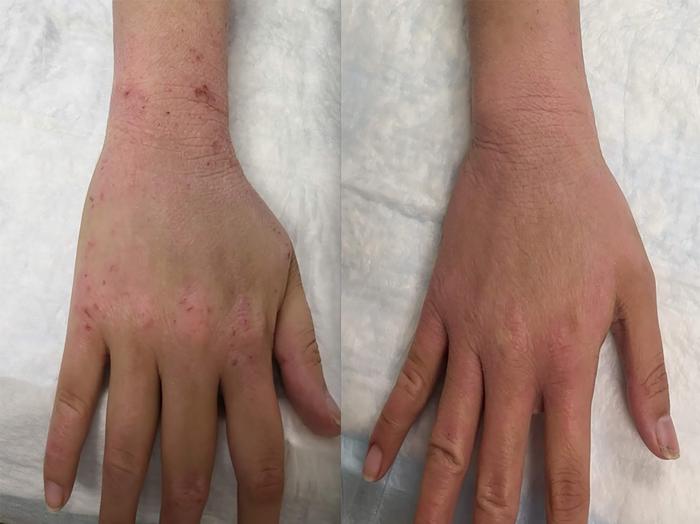
Researchers at the National Institutes of Health (NIH) have shed light on a condition that has been largely unaddressed in dermatological circles—topical steroid withdrawal (TSW). For many individuals enduring the adverse effects of prolonged topical steroid use, TSW can bring about a range of debilitating symptoms, yet the precise mechanisms responsible for these symptoms have remained obscure. This new research aims to distinguish TSW from other prevalent skin conditions such as eczema, providing newfound clarity and potential strategies for treatment and diagnosis.
The alarming rise in instances of TSW can be attributed to an increasing reliance on topical steroids in the treatment of dermatitis. While these medications offer quick relief from inflammation and itching, and have long been viewed as safe and effective, the consequences of long-term use are beginning to surface. Many patients, after ceasing the use of topical steroids, encounter a cascade of symptoms that can worsen well beyond the initial dermatological issues they sought treatment for. This phenomenon invites an urgent need for a clearer understanding and a comprehensive treatment regime.
The NIH study, published in the esteemed Journal of Investigative Dermatology, dives deep into these complexities. Through rigorous analysis of 1,889 survey subjects exhibiting eczema-like symptoms, researchers were able to identify a critical differentiating factor between two groups: those experiencing TSW and those without. By comparing serum and skin levels of nicotinamide adenine dinucleotide (NAD+), a pivotal compound in mitochondrial function and cellular metabolism, the researchers were able to establish a unique biochemical fingerprint associated with TSW.
The study’s findings suggest not only a correlation but a potential causative relationship between elevated NAD+ levels and the inflammation witnessed in TSW patients. This is a groundbreaking conclusion, implying that the systemic effects of topical steroids extend far beyond the immediate application sites and are rooted in deeper biochemical disturbances. By charting this connection, scientists can now pivot towards therapeutic options designed to restore balance to NAD+ levels, which may include the administration of mitochondrial complex I-blocking drugs.
In laboratory conditions replicating TSW, researchers observed that elevating NAD+ levels led to inflammatory responses within skin cells. This discovery elucidates the underlying pathophysiology of TSW and opens avenues for intervention strategies. The use of established medications such as metformin and berberine, which serve to inhibit mitochondrial function and thereby potentially reduce NAD+ production, presents an exciting frontier in tackling this condition. Initial results from pilot studies indicate that patients using these drugs reported significant alleviation of TSW symptoms after just a few months of treatment.
Using these insights, the NIAID team has put forth provisional criteria for healthcare providers to identify TSW in their patients. This is of paramount importance, as traditional diagnostic approaches have failed to differentiate between TSW and other forms of dermatitis. The criteria emerging from this research could enable more accurate identification and earlier intervention, which would ultimately mitigate the physical and emotional suffering endured by affected individuals.
The implications of this research stretch far beyond mere academic curiosity; they echo within the real-world context of patient care. By understanding that TSW is accompanied by specific metabolic changes, healthcare practitioners can formulate more effective treatment plans tailored to individual patient needs. As TSW is often misdiagnosed or overlooked entirely, this clarity could dramatically enhance patient outcomes and offer relief to those suffering in silence.
Further research is urgently needed to determine whether the observed elevations in NAD+ are a universal feature of TSW, or if there are diverse subtypes within this complex illness. By refining diagnostic criteria and exploring the underlying biological mechanisms, scientists can uncover additional features that characterize TSW, possibly leading to broader insights into the effects of corticosteroid use across the population.
In light of these findings, it becomes necessary for both patients and practitioners to engage in open discussions about the potential risks associated with long-term topical steroid use. Awareness campaigns might help to educate the public regarding safe usage practices and the importance of closely monitoring symptoms. Such proactive measures could serve not only to lower the incidence of TSW but also minimize the broader implications of chronic steroid use in dermatology.
Moreover, understanding the unique metabolic pathways associated with TSW may inspire novel treatment protocols that integrate current dermatological methodologies with metabolic interventions. The future of this field appears promising, yet dependent on ongoing discourse and research. As the medical community continues to advocate for patient-centered care, it is crucial to harness these findings to drive changes in clinical practices.
The study highlights an evolution in the way conditions like dermatitis are understood and treated, moving from a traditional reliance on symptomatic relief to a more holistic approach that considers the metabolic implications of treatment strategies. This paradigm shift embodies a significant leap forward for dermatology, promising to redefine standards of care for those affected by TSW and similar ailments. As the implications of this research continue to unfold, we stand on the precipice of a new era in skin health.
This ongoing research will not only benefit individuals suffering from TSW but may also inform treatment strategies for other steroid-related conditions. The increased focus on metabolic health in skin disorders could expand the horizons of dermatological research and lead to the development of standardized practices that better manage not only TSW but other inflammatory skin diseases as well. As we harness the knowledge extracted from such studies, we pave the way for a future wherein dermatological care is as nuanced and dynamic as the conditions it seeks to treat.
In conclusion, the distinguishing findings surrounding topical steroid withdrawal offer a transformative narrative in dermatology. With the identification of NAD+ as a pivotal player in this condition, there lies potential for effective therapeutic avenues previously unconsidered. The meticulous efforts of researchers at NIH represent not just an advancement in our understanding of TSW but a promise of hope for the countless individuals navigating the complexities of steroid withdrawal and dermatitis.
Subject of Research: Topical Steroid Withdrawal (TSW)
Article Title: Distinguishing Topical Steroid Withdrawal: New Insights from NIH Research
News Publication Date: [Not provided]
Web References: [Not provided]
References: [Not provided]
Image Credits: NIAID
Keywords: Dermatitis, Topical Steroid Withdrawal, NAD+, Eczema, Mitochondrial Complex I, Berberine, Metformin, Clinical Trials, Skin Disorders, Patient Care
Tags: dermatological conditions and treatmentseczema vs topical steroid withdrawalincreasing reliance on topical steroidsJournal of Investigative Dermatology studylong-term effects of topical steroidsNIH research on TSWpatient experiences with TSWstrategies for managing TSWsymptoms of topical steroid withdrawaltopical steroid withdrawal diagnosistreatment options for steroid withdrawal symptomsunderstanding topical steroid dependence





